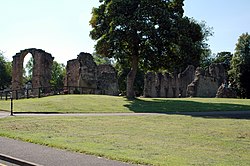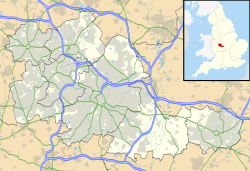
Lichfield Cathedral, formally the Cathedral Church of Saint Mary and Saint Chad in Lichfield, is a Church of England cathedral in the city of Lichfield, England. It is the seat of the bishop of Lichfield and the principal church of the diocese of Lichfield. There are daily services at the cathedral, which has been designated a grade I listed building.

Dudley is a market town in the West Midlands, England, 6 miles (9.7 km) southeast of Wolverhampton and 8 miles (13 km) northwest of Birmingham. Historically part of Worcestershire, the town is the administrative centre of the Metropolitan Borough of Dudley. In the 2011 census, it had a population of 79,379. The wider Metropolitan Borough had a population of 312,900. In 2014, the borough council adopted a slogan describing Dudley as the capital of the Black Country, a title by which it had long been informally known.
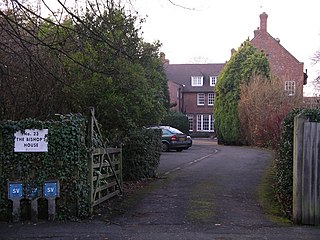
The Bishop of Coventry is the ordinary of the Church of England Diocese of Coventry in the Province of Canterbury. In the Middle Ages, the Bishop of Coventry was a title used by the bishops known today as the Bishop of Lichfield.

The Diocese of Worcester forms part of the Church of England (Anglican) Province of Canterbury in England.

Thetford Priory is a Cluniac monastic house in Thetford, Norfolk, England. Founded in 1103 by Roger Bigod of Norfolk, Thetford was one of the most important monasteries of East Anglia.
The Priory Estate is a housing estate in Dudley, West Midlands, England, which has largely been developed since 1929.
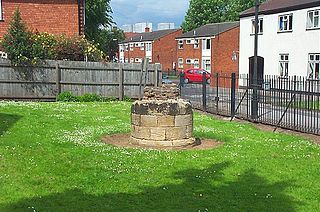
Lenton Priory was a Cluniac monastic house in Nottinghamshire, founded by William Peverel circa 1102-8. The priory was granted a large endowment of property in Nottinghamshire and Derbyshire by its founder, which became the cause of violent disagreement following its seizure by the crown and its reassignment to Lichfield Cathedral. The priory was home mostly to French monks until the late 14th century when the priory was freed from the control of its foreign mother-house. From the 13th-century the priory struggled financially and was noted for "its poverty and indebtedness". The priory was dissolved as part of King Henry VIII's Dissolution of the Monasteries.

Lewes Priory is a part-demolished medieval Cluniac priory in Lewes, East Sussex in the United Kingdom. The ruins have been designated a Grade I listed building.

In the Middle Ages, from the 11th century, the Cluniac order established a number of religious houses in England, Wales, and Scotland.

St James' Church is in the village of Audlem in south Cheshire, England. It is recorded in the National Heritage List for England as a designated Grade I listed building.

Gresley Priory was a monastery of Augustinian Canons regular in Church Gresley, Derbyshire, England, founded in the 12th century.
Priory of St. Thomas near Stafford was an Augustinian religious house near Stafford, Staffordshire, England. Founded sometime in approximately 1174, it was a surrendered to the Crown in 1538, during the Dissolution of the Monasteries.
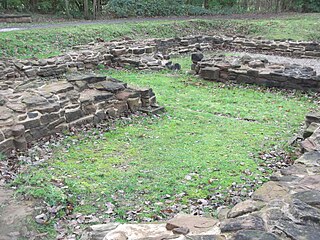
Sandwell Priory was a small medieval Benedictine monastery, near West Bromwich, then part of Staffordshire, England. It was founded in the late 12th century by a local landowner and was only modestly endowed. It had a fairly turbulent history and suffered considerably from mismanagement. It was dissolved in 1525 at the behest of Cardinal Wolsey – more than a decade before the main Dissolution of the Monasteries under Henry VIII.

St Mary's Priory and Cathedral was a Roman Catholic institution in Coventry, England, founded in the 12th century by transformation of the former monastery of St Mary, and destroyed during the Dissolution of the Monasteries in the early 16th century. It was located on a site north of Holy Trinity and the former St Michael's parish churches in the centre of the city, on a site bordered by Priory Row to the south, Trinity Street to the west, and the River Sherbourne to the north. Excavated remains from the west end of the cathedral are open to the public.
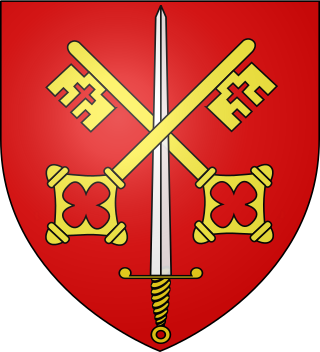
St. James Priory, also known as Derby Cluniac Priory, was a Benedictine monastery, formerly located in what is now Derby City Centre. It existed until the Dissolution of the Monasteries.

Morville Priory was a small Benedictine monastery in Shropshire, England, a cell of Shrewsbury Abbey.
Gervase Paganell inherited the feudal barony of Dudley around the year 1150. However, after rebelling against King Henry II, his castle was demolished. Gervase founded the Cluniac Priory of St James in Dudley and probably founded the Church of St Thomas in Dudley. He died in 1194.
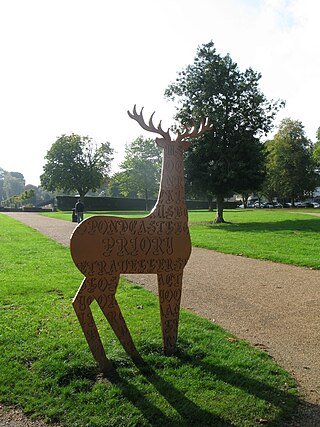
Priory Park is a public park located in Dudley, West Midlands, England, just north of the town centre. It is in the historic grounds of Dudley Priory.

Christ Church is an Anglican church in Coseley, West Midlands, England, and in the Diocese of Worcester. It was built in 1830; the interior has many additions of the late 19th and early 20th century. It is Grade II listed.
